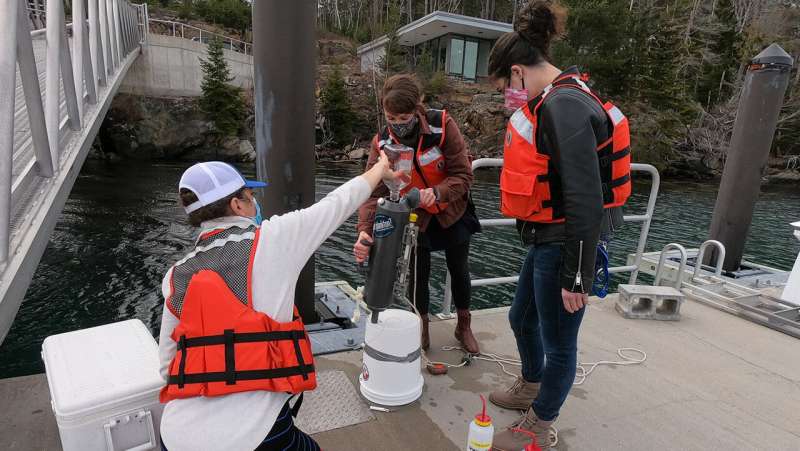This article has been reviewed according to Science X's editorial process and policies. Editors have highlighted the following attributes while ensuring the content's credibility:
fact-checked
trusted source
proofread
Study highlights importance of everyday interactions in environmental research

Scientific research can often feel prescriptive, sterile and disconnected from the communities where it happens—but it doesn't have to be. Using two case studies of watershed restoration and environmental monitoring projects in Maine, a new paper illustrates how scientists can successfully use "embodiment," or the nuanced practices and everyday interactions that shape collaboration, to improve their research.
The authors of the study, from the University of Maine, assert that "embodiment" encompasses the many ways in which people interact while collaborating, from listening, sharing and organizing ideas to fostering empathy, deciding what questions to ask, working through tensions and laughing together. The paper is published in the journal Communication Design Quarterly.
"Our work pays attention to the many ways in which bodies are a foundational part of research, from the ways bodies participate, collaborate within, are studied, conduct studies, write together and are written (or not written) about," says Jennifer Smith-Mayo, Ph.D. student in communication and co-author of the study. "This focus on embodiment draws attention to research practices that, in the process of striving for objectivity in data, may make bodies involved in that research invisible or detach them from the research context."
To show how embodiment can be used in practice to improve research methods, Mayo and her colleagues Michael Clay, Ph.D. candidate in communication and journalism at UMaine, and Bridie McGreavy, associate professor of environmental communication, highlighted two case studies: the Meduxnekeag River watershed restoration and Maine-eDNA project. Both focus on embodiment to structure their research processes and shape ongoing, emergent and collaborative research practices.
For Maine-eDNA—UMaine's research, education and outreach program that aims to transform the understanding and sustainability of Maine's coastal ecosystems via environmental DNA (eDNA)—the researchers conducted a team science knowledge mapping activity, where collaborators in the project were asked to define eDNA and all the concepts connected to it. Though a seemingly simple task, focusing on elements of embodiment in collaborative communication allowed the group to reflect on and negotiate the scientists' relationship with the community—for example, the importance of ethical communication practices as an ongoing commitment for eDNA work.
"Focusing on the embodied practices and processes of putting together something like a knowledge map can give collaborators a way of sensing and working across differences that wouldn't otherwise exist on a project," says McGreavy. "In the case of eDNA, the knowledge mapping created spaces for collaborators to identify differences in how they imagined eDNA science connecting with communities, which opened up new conversations and insights about ethics and engagement."
In the Meduxnekeag River watershed case study, the researchers worked with partners to design an interview protocol that asks farmers how the act of farming helps them shape their relationships with land and water in the watershed, the values that guide those practices and how they think about best management practices. The results showed how important caring for soil is to the ways that farmers relate to, make decisions about and find value in land and water throughout the Meduxnekeag watershed.
"What makes the Meduxnekeag River watershed case study so interesting is how it helped us consider how to connect research design in community-engaged research with everyday, lived experiences of our community partners," says Clay. "You can see this play out in how our questions shifted from persuading farmers, or determining what communication approaches they will find compelling, to better understanding farmers' relationships and perspectives as they relate to soil, water and farming practices."
According to the authors, the success of the case studies show that framing research in terms of embodiment offers a means to better understand how communication practices shape collaboration and knowledge co-production. We also discuss how engaged research projects that attend to embodiment can offer partners and researchers opportunities to modify or reshape a project's efforts to improve collaboration and strengthen community relationships.
"These case studies show that engaging with embodiment can be a valuable approach to collaborative research design with community partners," Smith-Mayo says. "Going forward, researchers can make commitments to embodied practices such as collaborative research design, paying attention to and attending to: partners' needs, active listening, engaging in dialogue, respect for each other, and reflexivity, an iterative practice of checking in with others and reflection. Such practices will continue to strengthen relationships between researchers and community partners as we collaborate to produce knowledge together."
More information: Michael Clay et al, Embodied Participation, Communication Design Quarterly (2023). DOI: 10.1145/3531210.3531213
Provided by University of Maine




















